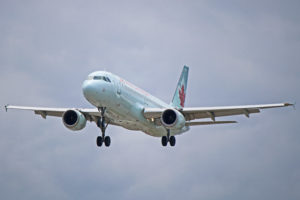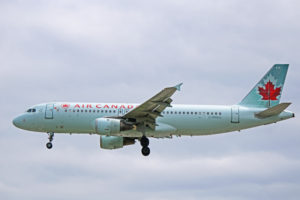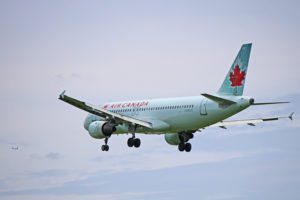 At 25 years old, C-FNVU has been around the block. The Airbus A320-200 started life with the now defunct Canadian Airlines in 1993 and wore the colours of former brand Air Canada Tango for a while. We photographed this A320 on May 20, 2018 while plane spotting at Toronto Pearson International Airport (YYZ).
At 25 years old, C-FNVU has been around the block. The Airbus A320-200 started life with the now defunct Canadian Airlines in 1993 and wore the colours of former brand Air Canada Tango for a while. We photographed this A320 on May 20, 2018 while plane spotting at Toronto Pearson International Airport (YYZ).
For full-size, high resolution versions for any of the photos in the image gallery, simply click on the individual pictures. See below for more detailed information on C-FNVU, the Airbus A320-200 model in general and the airline.
Image Gallery
C-FNVU
Airbus A320-200
Air Canada
Resources
C-FNVU Air Canada Airbus A320-200 Image Gallery
Want to use one of these photos for your website, blog or news site? They’re free to use – take a look at our Photo Usage Policy.
C-FNVU
C-FNVU performed its maiden flight on January 19, 1993 and was delivered to Canadian Airlines the following week. When Canadian was merged into Air Canada, the Airbus A320-211 joined its current airline on April 4, 2001.
Later that year, on November 1, 2001, C-FNVU became part of low cost brand Air Canada Tango. That subsidiary was founded in 2001 and ceased operations in 2004. While in business, Tango flew a fleet of Airbus A320-200 and Boeing 737-200 aircraft. This particular airliner was returned to the main fleet on September 30, 2003.
C-FNVU is configured for a maximum total of 146 passengers. There are 14 seats in business class and 132 economy class seats. This is currently one of 42 A320 models in the main fleet with phase-outs expected to begin in 2019.
On December 8, 2010, the aircraft was flying from Toronto, Ontario to St. John’s, Newfoundland. On the initial climb, at around 8,000 feet, the aircraft experienced two bumps and crew received an ‘ENG 2 REV UNLOCKED’ message. The right side engine was shut down and the A320 was diverted back to Toronto for a safe landing. As a result, the primary latch for the lower outboard reverser fan door on that engine was replaced, along with the hydraulic control unit and a wiring harness.
On January 30, 2012, the airliner was flying from Fort Lauderdale Hollywood International Airport in Florida to Toronto. On final approach to YYZ, C-FNVU had to go around and climb back to 3,000 feet after an aircraft on the ground did not vacate the runway quick enough. Unfortunately, there was some confusion and an Embraer ERJ-145 was also told to stop their initial climb at 3,000 feet, putting the two aircraft on a converging flight path. Despite the error, all went well and both airplanes continued safely to their destinations.
Early in 2017, on February 26, the Airbus A320-200 was flying from Winnipeg, Manitoba to Toronto. At 28,000 feet on the climb out of YWG, it was noticed the cabin altitude was climbing. The aircraft descended to 10,000 feet and diverted back to Winnipeg for a safe landing. The condition was caused by an inoperative #2 air conditioning pack with a cracked heat exchanger and the #1 pack becoming inoperative during the flight.
On August 18, 2017, C-FNVU was flying again from Winnipeg to Toronto. On descent toward Toronto, crew were warned that there was a nose wheel steering fault. After a safe landing, the aircraft needed to be towed to the terminal. As a result, a corroded nose wheel steering connector was cleaned and the nose wheel steering servo control was replaced.
Airbus A320-200
The initial variant in the Airbus A320 Family, the Airbus A320-200 was introduced with launch customer Air France in 1988. Since, nearly 4,400 have been delivered. The airliner is 38 metres or 123 feet in length with a wingspan of 36 metres or 118 feet. At the tail, the airplane is 12 metres or 39 feet in height. The flight range is 6,100 kilometres.
Air Canada
Air Canada was founded as Trans Canada Air Lines in 1937. The name was officially switched on January 1, 1965. There are around 175 aircraft in the main fleet with over 400 when subsidiaries are included. The largest in the fleet is the Boeing 777-300ER. The airline flies to over 200 destinations around the world (350 with subsidiaries included).
Headquartered at the Air Canada Centre on the grounds of Montreal Pierre Elliott Trudeau International Airport (YUL) in Dorval, Quebec, the airline is a founding member of the Star Alliance. Other founding members include Lufthansa, Scandinavian Airlines, Thai Airways and United Airlines. There are now 27 full member airlines worldwide.
Resources
Winnipeg James Armstrong Richardson International Airport
Toronto Pearson International Airport
St. John’s International Airport




